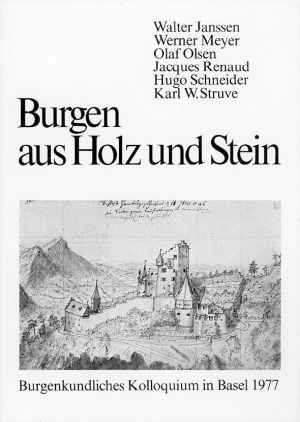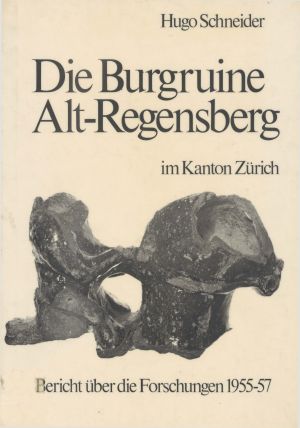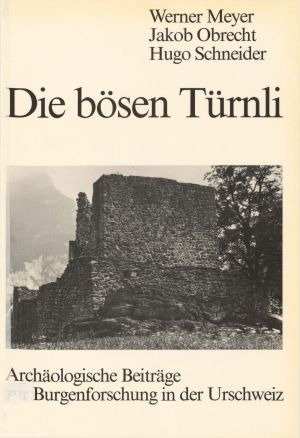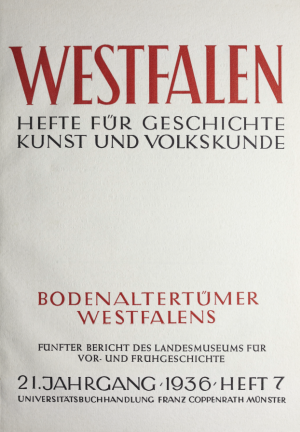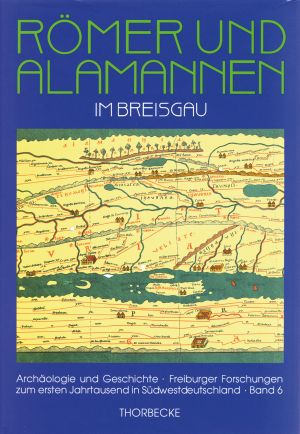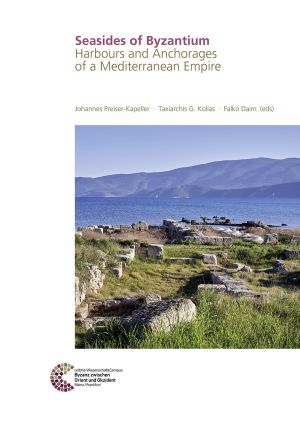Hugo
Burgen aus Holz und Stein: Burgenkundliches Kolloquium in Basel 1977
This volume contains the proceedings from a conference on castle studies held in Basel in 1977 to celebrate the 50th anniversary of the founding of the Schweizerischer Burgenverein. Looking back over half a century of the association’s existence, which has a good reputation in academic circles both here and abroad, the conference programme was intentionally wide-ranging. The contributions from various researchers in Switzerland and abroad point to the diversity of medieval defensive structures in terms of form, function and materials. The six presentations share an important leitmotif in current medieval research: interlinking archaeological features with historical contexts. The volume contains two Swiss papers; Hugo Schneider’s paper on Letzi walls (defensive barriers or boundary markers) in the Alpine region puts the spotlight on the founding period of the Old Swiss Confederacy, while Werner Mayer attempts to make an archaeological contribution to the medieval history of settlement by examining the links between castle construction, the rise of political power and forest clearance rights. Using lowland castles in the Rhineland as an example, Walter Janssen sheds light on the transition between timber construction and stone architecture in the High Middle Ages and examines the social status of individual noble lineages based on the differences in the construction of their castles. Similarly, Jacques Renaud uses 13th/14th century brick-built castles in the Netherlands to present the history of Dutch feudalism. Based on the geographic locations and types of construction of timber-built Slavic castles in north-western Germany, Karl Struve examines the social structure of the Slavic tribes. Olaf Olsen’s paper on concentric castles in Denmark provides an insight into the military and political organisation of Danish kingship at the time of the Vikings.
Die Burgruine Alt-Regensberg im Kanton Zurich: Bericht über die Forschungen 1955-57
The excavation and renovation of the castle ruins of “Altburg”, the ancestral seat of the Barons of Regensberg near Zurich, were carried out on behalf of the Department of Public Works of Canton Zurich in close cooperation with the Swiss National Museum. The project provided a unique opportunity to study and document an early castle complex of great historical importance. The castle itself is located on a morainic hill, which was fortified by the Barons of Regensberg at the end of the 11th century. The fortifications were extended around 1200 under the Barons of Regensberg and during the 14th century under the lords of Landenberg. In 1460 the complex was modernised by Rudolf Mötteli, but this was met with opposition from the city of Zurich, which ultimately took it over and let it fall into ruin.
The publication links the history of owners with the history of construction, paying most attention to the Barons of Regensberg, followed by a detailed presentation of the excavated features. The four main phases from the high to the late Middle Ages are presented separately, with an illustrated catalogue containing several hundred objects, divided into different categories, which include stove tiles, pots and other ceramic vessels, iron, coins, non-ferrous metal as well as bone.
Die bösen Türnli: Archäologische Beiträge zur Burgenforschung in der Urschweiz
This volume contains reports on the excavations and architectural investigations carried out at several castle sites in the cantons that made up the “Old Swiss Confederacy”. Six sites are presented: the castle ruins at Attinghausen, Seedorf, Zwing Uri, Gesslerburg, Schanau and Landenberg above Sarnen. The final chapter by Werner Meyer deals with the construction and demolition of castles in the region that is considered to have constituted the “Old Swiss Confederacy”. The book also contains numerous photographs and drawings.
Bodenaltertümer Westfalens: Vierter Bericht der vorgeschichtlichen Abteilung des Landesmuseums
In: Westfalen, Hefte für Geschichte, Kunst und Volkskunde 20/5, 1935, Seiten 209-296
Bodenaltertümer Westfalens: Fünfter Bericht der vorgeschichtlichen Abteilung des Landesmuseums
In: Westfalen, Hefte für Geschichte, Kunst und Volkskunde 21/7, 1936, Seiten 357-492
Römer und Alamannen im Breisgau: Studien zur Besiedlungsgeschichte in Spätantike und frühem Mittelalter
Christel Bücker hat die römischen sowie frühalamannischen Keramikfunde vom Zähringer Burgberg bei Freiburg ausgewertet. Ihre Ergebnisse zeigen, dass die gewaltigen Baurnaßnahmen auf dem Burgberg in der Spätantike stattfanden und dazu dienten, die Bergkuppe zu einer etwa 5 ha großen ebenen Siedlungsfläche umzugestalten. Darüber hinaus wird die Keramik vorgestellt, woraus ein fortgeschrittener Grad der Romanisierung dieser alamannischen Oberschicht erschlossen werden kann. Die Studie bildet die Basis für alle weiteren kulturgeschichtlichen Auswertungen nicht nur zur Höhensiedlung auf dem Zähringer Burgberg, sondern auch zu den ländlichen Siedlungen in der Breisgauebene.
Michael Hoeper hat in seinem Beitrag alle frühalamannischen und merowingerzeitlichen Fundstellen, Siedlungen und vor allem Gräberfelder, registriert, ihre Verbindung zu den Ortsnamen analysiert und die Lage der Friedhöfe innerhalb der seit dem Anfang des 19. Jahrhunderts überlieferten Gemarkungsgrenzen beschrieben. Der Gang der Besiedlung ist für den gesamten Breisgau an der Abfolge der Ortsnamen und über die Reihengräber zu beschreiben. Auffällig ist die Beziehung zwischen den Orten auf -heim und den ehemals römischen Siedlungszentren. Außerdem wird das alte Modell des Besiedlungsbildes, dass die Siedlungen an der gleichen Stelle wie die heutigen Dörfer bestanden, ersetzt durch ein differenziertes Modell.
Hugo Steger greift eine aus dem 19. Jahrhundert überkommene Fehlinterpretation des Ortsnamens Riegel am Kaiserstuhl auf. Im Einklang mit zahlreichen lateinischen, altitalienischen und bairischen Belegen erweist sich das frühalthochdeutsche (8.Jh.) Femininum riegula/reigula aus lat. regula für Riegel als eine lateinische Bezirksbezeichnung. Die Frage einer civitas in Riegel kann damit neu diskutiert werden. Nicht ein alter Ortsname, sondern die Bezirksbezeichnung wurde als neuer Ortsname übernommen. Eine intensive Neuinterpretation antiker Geographien und Reisehandbücher sowie archäologischer und flurnamenkundlicher Zeugnisse für die römischen Hauptstraßen im Bereich Breisach – Wolfenweiler – Umkirch – Riegel begründet die Hypothese, dass der alte Ortsname für Riegel [H]Elvetum war.
Seasides of Byzantium: Harbours and Anchorages of a Mediterranean Empire
In recent years, interest in the study of maritime installations and networks in the Roman and Byzantine Mediterranean has increased considerably, as documented by various projects and publications.
The conference »Seasides of Byzantium. Harbours and Anchorages of a Mediterranean Empire«, from which the papers collected in the present volume emerged, took place in Athens in 2017 as part of a cooperation between the DFG-funded Special Research Programme (SPP 1630) »Harbours from the Roman Period to the Middle Ages« and the National Hellenic Research Foundation. It united historians, archaeologists and geoarchaeologists to explore harbours and anchorages as core maritime infrastructure to the Late Roman and Byzantine Empire.
General phenomena such as the organisation of the Byzantine navy and its operations or lighthouses are discussed in this volume as well as new geoarchaeological research methodologies in harbour archaeology. Most contributions in the present volume examine case studies for the most important maritime core region of the Byzantine Empire, the Aegean. This sea connected the remaining provinces of the empire in Southeastern Europe and Asia Minor after the loss of Syria, Palestine, Egypt, and North Africa to the Arabs in the 7th century AD. In addition to technical and geographical aspect, the studies in this volume make clear that we need to explore more and more the social embedding of the seasides of Byzantium to understand their dynamics in all their complexity.



